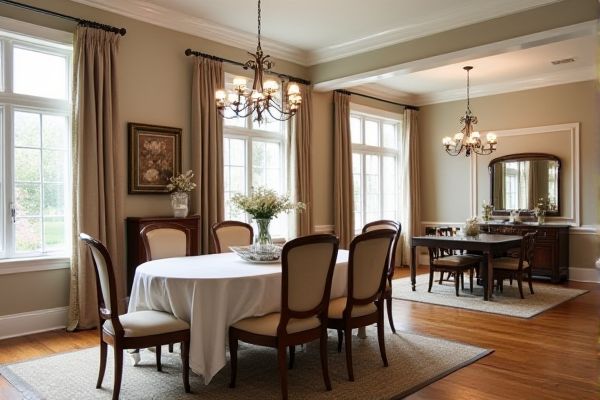
A formal dining room offers a dedicated, elegant space for hosting special occasions, often featuring traditional decor and a larger table, while an informal dining area provides a casual, versatile setting typically integrated with the kitchen or living space for everyday meals. Explore the rest of the article to discover which dining setup best suits your lifestyle and home design preferences.
Table of Comparison
| Feature | Formal Dining Room | Informal Dining Area |
|---|---|---|
| Purpose | Special occasions, formal meals | Everyday dining, casual meals |
| Location | Separate room, dedicated space | Open space, often part of kitchen or living room |
| Furniture | Elegant table, matching chairs, often with sideboard | Smaller table, versatile chairs or benches |
| Decor | Formal settings, chandeliers, fine china | Simple decor, functional items |
| Seating Capacity | Larger, accommodates guests | Smaller, family-sized |
| Use Frequency | Occasional use | Daily use |
Introduction to Formal vs Informal Dining Spaces
Formal dining rooms are designed for special occasions and typically feature elegant furnishings, coordinated decor, and a fixed location separate from other living areas. Informal dining areas prioritize functionality and comfort, often integrated within kitchens or living rooms for everyday use and flexible seating arrangements. The choice between these spaces depends on lifestyle preferences, entertaining habits, and available square footage in the home.
Defining Characteristics of Formal Dining Rooms
Formal dining rooms feature elegant furniture, coordinated decor, and often include a large dining table with matching chairs designed for special occasions. They emphasize a polished ambiance with elements like chandeliers, fine china, and a dedicated space separate from everyday living areas. Your home's formal dining room serves as a refined setting for hosting guests and celebrating important events.
Key Attributes of Informal Dining Areas
Informal dining areas emphasize comfort and practicality, featuring casual furniture, easy-to-clean surfaces, and flexible layouts that accommodate everyday meals. These spaces often integrate with kitchens or living rooms, promoting convenience and social interaction. Natural lighting and minimalistic decor enhance the relaxed atmosphere, distinguishing informal dining from the more structured and elegant formal dining rooms.
Design Aesthetics: Elegance vs Comfort
Formal dining rooms emphasize elegance through sophisticated design elements like chandeliers, fine china displays, and ornate furniture that create a refined atmosphere. Informal dining areas prioritize comfort with casual seating, practical layouts, and warm, inviting decor to encourage relaxed gatherings. The contrast in design aesthetics reflects the intended use: formal spaces for special occasions and informal areas for everyday meals.
Functionality and Usage Patterns
A formal dining room is designed for special occasions and gatherings, emphasizing elegance and structured seating arrangements, enhancing the overall dining experience. Informal dining areas prioritize convenience and daily use, often integrated with kitchens or living spaces for quick meals and casual interactions. Your choice between the two influences how often and in what manner meals are enjoyed, balancing practicality with social ambiance.
Furniture Choices: Traditional vs Casual
Formal dining rooms typically feature traditional furniture choices such as ornate wooden tables, upholstered chairs, and matching sideboards that emphasize elegance and sophistication. Informal dining areas favor casual furniture like lighter wood or metal tables, mix-and-match chairs, and benches for a relaxed, comfortable vibe. Your selection should reflect the room's intended atmosphere, balancing aesthetics with daily usability.
Space Requirements and Layout Considerations
Formal dining rooms require ample space to comfortably accommodate larger tables, multiple chairs, and additional furniture like buffets or china cabinets, often positioned in a separate, dedicated room to enhance an elegant atmosphere. Informal dining areas typically have compact layouts integrated within kitchens or living spaces, prioritizing functionality and ease of access with smaller tables or breakfast nooks. Your choice between these options will impact home flow, with formal rooms allowing for a structured dining experience and informal areas offering versatility and convenience.
Entertaining Guests: Formality vs Relaxation
A formal dining room creates an elegant atmosphere for entertaining guests, emphasizing sophisticated decor, structured seating, and refined table settings that encourage a special occasion feel. In contrast, an informal dining area promotes relaxation and casual interaction, often featuring flexible layouts and comfortable furniture ideal for everyday meals and spontaneous gatherings. Your choice between the two depends on whether you prioritize formality and tradition or comfort and ease when hosting guests.
Maintenance and Cleaning Demands
Formal dining rooms typically require more intensive maintenance and cleaning due to their larger size, elaborate decor, and use of specialty materials like fine china and crystal. Informal dining areas often feature simpler designs and durable surfaces, making upkeep easier and quicker for Your daily routine. Selecting an informal space can reduce frequent deep-cleaning sessions and lower the risk of damage from frequent use.
Choosing the Right Dining Option for Your Home
Formal dining rooms offer a structured, elegant space ideal for hosting special occasions and dinner parties, often featuring high-end furniture and decor that elevate the dining experience. Informal dining areas provide a more casual, flexible environment perfect for everyday meals and family gatherings, typically integrated with kitchens or living spaces for convenience. Choosing the right dining option for your home depends on your lifestyle, entertaining frequency, and space availability to balance comfort and functionality.
 homyna.com
homyna.com